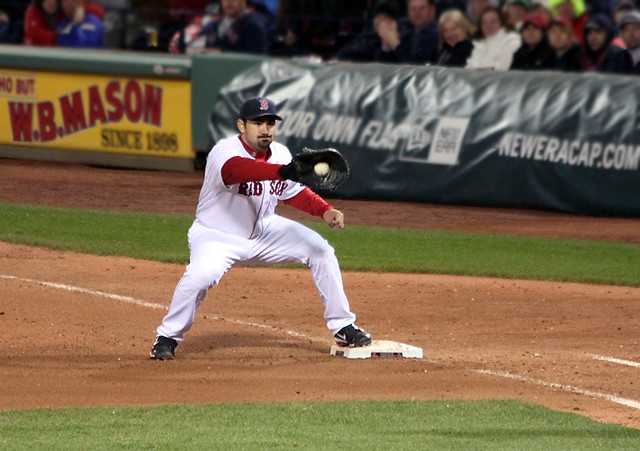
Ex-Red Sox player Adrian Gonzalez (Photo: Samara Pearlstein)
If you haven’t heard, the Red Sox have traded Adrian Gonzalez, Josh Beckett, Carl Crawford and Nick Punto to the Dodgers for James Loney, Allen Webster and Ivan De Jesus Jr. (with Rubby De La Rosa and Jerry Sands as players to be named later). And you may ask yourself, how did we get here?
Here’s how the Red Sox got here. The Red Sox tried to keep up with the Joneses. The Joneses are the New York Yankees. The Yankees have too much money to compete with on the free agent market. There it is. It was complete folly for the Red Sox to try to compete with the combined strength of Yankee will and their ability to spend due to their television money. But Ben Cherington found that the Red Sox’s financial weakness in the AL East could lead to a turnaround for the club.
In the Dodgers, Cherington found a willing trade partner with a new ownership group willing to make a big statement. More importantly, the Dodgers are a team that is renegotiating its television contract, which very likely will net the Dodgers at least $4 billion over 10 years. So the Dodgers had the money to absorb bad contracts.
Ben Cherington played the Dodgers like a fiddle. He jettisoned the contracts of Josh Beckett and Carl Crawford in this deal. The price for that jettison was Adrian Gonzalez. That Cherington was able to do such a trade during the waiver period was amazing. What makes the trade a boon is the return.
In exchange for clearing approximately a quarter of a billion dollars in payroll, the Red Sox got a warm body in James Loney to man first base for the rest of the season but also got four, count them, FOUR, prospects in the deal. Two of the prospects are darned good pitching prospects in Allen Webster and Rubby De La Rosa, along with 1B/OF Jerry Sands and Ivan De Jesus Jr., a utility infielder.
Allen Webster is the cornerstone of the deal. Ranked as the #2 prospect of the Dodgers by Baseball America entering into the 2012 season, Webster’s sinking fastball reminds scouts of a good Derek Lowe, and projects as a solid #2 pitcher. Nice.
Rubby (pronounced “Ruby”) de la Rosa is the enigma of the deal. Once a top prospect in the Dodgers organization, de la Rosa underwent Tommy John surgery. However, he is now back from his recovery (think Daisuke Matsuzaka in his stage of recovery). de la Rosa once threw 102 MPH before the surgery. He also needs to develop a third pitch to be thought of as a very good #2 starter. But even if de la Rosa lands in the bullpen, he definitely seems an excellent asset.
Jerry Sands, a combination 1B/OF, seems to me a Paul Goldschmidt type of player. Sands has had great power numbers at Albuquerque, but that park (and the Pacific Coast League in general) has been a hitter’s haven. But the Red Sox hope that his power will translate to Fenway. In 2013, he could start at first base if the Red Sox get desperate but, at worst, could be a valuable bench piece going forward.
Ivan De Jesus Jr. is Pedro Ciriaco lite. He plays all over the infield and hasn’t proven himself in the majors. Look for him to start in Pawtucket in 2013.
All in all, Ben Cherington made an excellent deal with the Dodgers. The Red Sox have recommitted the team to the “player development machine” that was promised way back when. There may be a lean year or two for the Red Sox, but if they turn up with a rotation of Clay Buchholz, Matt Barnes, Allen Webster, Rubby De La Rosa and Felix Doubront in 2014, with an option on Jon Lester, this trade will have been the catalyst for that rotation.
